Anxiety, a prevalent mental health condition, affects millions of individuals globally, driving many to seek effective methods beyond traditional therapies. One intriguing alternative gaining attention is the use of isochronic binaural beats, a form of soundwave therapy that has demonstrated potential in alleviating anxiety symptoms. This approach, grounded in scientific principles, offers a novel method for managing anxiety, although it is important to note that it is not a substitute for established medical treatments but rather a complementary tool.
Binaural beats are one of the subcategories of brainwave entrainment technology known as isochronic binaural beats. Isochronic beats are not like binaural beats that need headphones to feed each ear with slightly different tones, instead, it use single tones that are in a pulse. These beats are supposed to entrain the brain waves to the desired frequency, such as alpha, beta, theta or delta. The concept is based on neural entrainment, which is the process by which external sounds can affect the brain’s natural oscillations and may result in improved relaxation or concentration.
The scientific research on binaural beats and their effects on anxiety is still in its infancy. However, initial studies offer some evidence. A study in the “Alternative Therapies in Health and Medicine” journal shows that binaural beat listeners had a decrease in anxiety levels as compared to those who were subjected to white noise. Also, the “Journal of Nervous and Mental Disease” reveals that binaural beats in the alpha range (8-14 Hz) help to decrease anxiety and enhance mood. These studies suggest that alpha waves which are linked with relaxation may reduce anxiety by making the mind more relaxed.
Practically, isochronic binaural beats are accessible through various audio recordings on platforms like YouTube, meditation apps (e.g. Good Vibes), and specialized websites. Users can incorporate these recordings into their relaxation routines, meditation sessions, or even daily activities to manage anxiety. The ease of use and availability make isochronic binaural beats an appealing option for those seeking non-pharmaceutical methods to manage anxiety.
However, it is important to note that isochronic binaural beats should not be used in place of traditional treatments. They are not the cure for anxiety as they only act as a tool to help in the management of the symptoms. People with severe or chronic anxiety should seek medical advice for proper management and treatment plan. Integrating conventional treatments with complementary treatments like isochronic binaural beats could be a better way to treat anxiety.
Binaural beats with the same frequency as the anxiety symptoms offer a viable, easy and non-pharmacological intervention. It is suggested that through the use of brainwave entrainment, one can be able to reduce the symptoms of anxiety and enhance their psychological health. However, it is crucial to consider isochronic binaural beats as an additional method rather than a replacement for conventional therapies. In the case of anxiety, incorporating such approaches with traditional treatments would improve mental health and emotional well-being.

